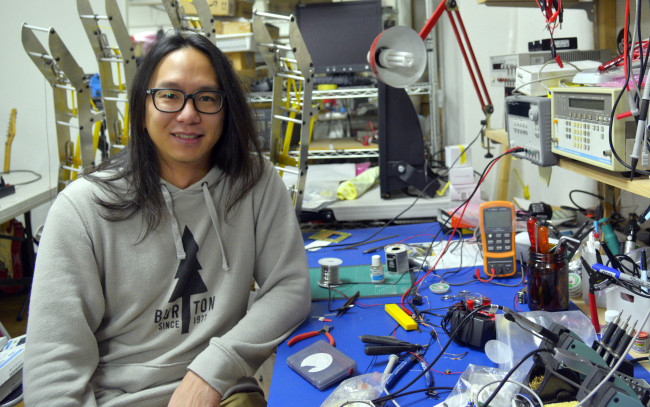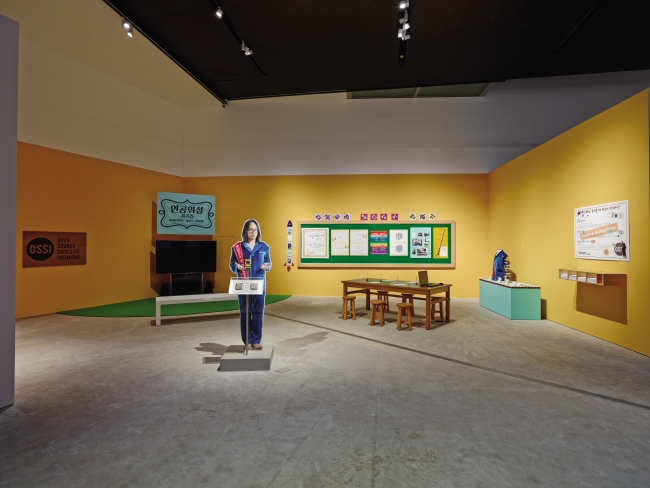Satellite man
Artist Song Ho-jun, the world’s first person to make and launch his own satellite, talks about science and art
By Lee Woo-youngPublished : Jan. 23, 2015 - 21:55
On April 19, 2013, a satellite was launched into space at Baikonur Cosmodrome, the international space launch site in Kazakhstan. The event went mostly unnoticed by the media, but the take-off was celebrated by a South Korean who became the first individual to launch his own satellite.
Usually, satellites are launched for specific purposes. They are used to monitor cloud patterns for weather, give GPS signals, or send back information about space or the Earth’s atmospheric conditions.
This satellite, however, had no known function. It was supposed to send signals down to Earth, but it never did.
No one knows its whereabouts.
“I suppose it fell from the orbit, burned up and disappeared,” said Song Ho-jun, the man behind this peculiar project, in an interview with The Korea Herald earlier this month.
Usually, satellites are launched for specific purposes. They are used to monitor cloud patterns for weather, give GPS signals, or send back information about space or the Earth’s atmospheric conditions.
This satellite, however, had no known function. It was supposed to send signals down to Earth, but it never did.
No one knows its whereabouts.
“I suppose it fell from the orbit, burned up and disappeared,” said Song Ho-jun, the man behind this peculiar project, in an interview with The Korea Herald earlier this month.

“I didn’t pay much attention to the orbit. I found out only after the launch that if a satellite has an ellipse-shaped orbit, instead of a circle, it could reenter the Earth’s atmosphere and burn up.”
The 37-year-old man is called an amateur scientist by some. But he regards himself as an artist.
Song never took art classes. He studied electrical engineering and computer science at college, went to a technology graduate school and briefly worked at a company that makes satellites.
He’s been an artist since 2005, mixing technology and art to make social commentary.
His previous works include a uranium necklace he specially designed for people who want to kill themselves. He used a uranium gemstone he bought from eBay and put the final work up for sale on the online marketplace again for 1 billion won ($923,000), which he described as the cost of a person’s life. Not surprisingly, eBay soon deleted his listing.

Another of his works, “The Strongest Weapon in the World,” is a round object that he claims cannot be destroyed by any nuclear bomb. Instead, in the event of nuclear devastation, it is designed to print out messages of love and gratitude on a piece of paper, he explained.
The satellite, however, was by far his biggest art project.
It began with a simple question: “Is it really not possible for an individual to launch a satellite into space?”
To find the answer, Song built a satellite with the help of his engineer friends and had the satellite installed on a Russian Soyuz rocket with the help of a French company.
Surprisingly, it wasn’t difficult at all to find the information needed to create the satellite. What he found very helpful were small research satellites made by students in the U.S., Japan and Switzerland.
The difficult part was to figure out how to get a launch rocket and permission from the government.
The project cost him more than $100,000. Most of the money came from a bank loan obtained by his parents, although he managed to raise some funds by selling T-shirts with the logo of his project, titled “Open Source Satellite Initiative.”
“The technology for making a satellite is not secret information,” he said. “What’s hidden is the information that government institutes hold ― the information you need to get your satellite on the launch pad.”
Despite all these investments, a successful satellite launch was not his main objective.
“I just wanted to show the world that there’s someone who actually brings an idea into action even if it sounds foolish,” he said.
His project caught people’s attention even before the launch.
The popular TV talk show “Radio Star” invited him as its first noncelebrity guest in September 2013. An independent movie director documented the making of the satellite and preparation for the launch over several years. The result, “Basement Satellite,” is slated for local release in February.
Song thinks the domain of space science is too exclusive.
Governments, particularly those of the developed countries, should share more of their information related to satellites and rockets, he believes.
“Being the first individual to send a satellite to space wasn’t my main interest. If an individual could do what many people think only governments are capable of and if an amateur like me can build one with information from the Internet, I thought the paradigm of the world might change,” Song said.
He resists the notion that science is the ultimate truth. He doesn’t believe that science will someday explain the human condition.
Such thoughts are summed up in the slogan “Science is Fantasy,” which hangs in his studio and appears at all the exhibitions he participates in. He thinks space science is one field in which science mingles with fantasy.
“I don’t take the approach that science can change everything. The thought really scares me,” he said.
What does art mean to him, then?
“Art is the field in which I can experiment with a lot of things. To me, art seemed like a field with a lower entry barrier for a novice like me,” he said.
The satellite project earned him some recognition as an artist.
Last year, Leeum, Samsung Museum of Art included him in a group exhibition of young, emerging artists. He is one of several international artists taking part in a current exhibition at Art Sonje Center in Seoul.
He has more exhibitions to look forward to this year, including one that starts in February at the Museum of Modern and Contemporary Art, Korea and another in Germany starting in March.
The attention, however, hasn’t tamed his free spirit.
In fact, he is beginning to have some doubts about the art world, he said.
“I’m not sure whether people really need to go to galleries to view artworks or artistic performances when you can see them on the Internet. I think (the gallery setting) somehow limits what an artwork can do to the viewers,” he said.
Song is an active social media user, posting while his works are in progress, presenting final works and receiving feedback on his website and Facebook page.
“In the gallery, a work is there for the sake of the work itself, not for the audience.”
He thinks art gets very little criticism from outside and that prevents diversity from growing in the art world.
“I think it’s easy to criticize science, but not art. That makes science a bitch and art a sophisticated bitch.”
Song plans to develop his satellite project further, present it in various art forms and generate new dialogues with audiences. He is also working on experimental music, through which he hopes to interact with more people.
“I want my art to have an impact on people. But it doesn’t always have to be an effective tool in delivering a certain message.”
By Lee Woo-young (wylee@heraldcorp.com)


![[Exclusive] Korean military set to ban iPhones over 'security' concerns](http://res.heraldm.com/phpwas/restmb_idxmake.php?idx=644&simg=/content/image/2024/04/23/20240423050599_0.jpg&u=20240423183955)

![[Graphic News] 77% of young Koreans still financially dependent](http://res.heraldm.com/phpwas/restmb_idxmake.php?idx=644&simg=/content/image/2024/04/22/20240422050762_0.gif&u=)



![[Pressure points] Leggings in public: Fashion statement or social faux pas?](http://res.heraldm.com/phpwas/restmb_idxmake.php?idx=644&simg=/content/image/2024/04/23/20240423050669_0.jpg&u=)









